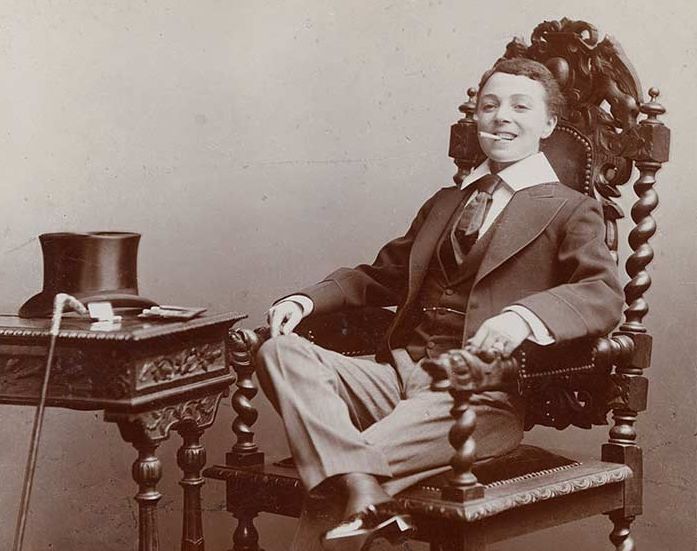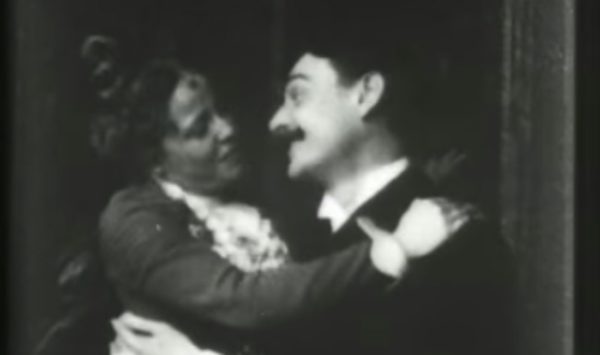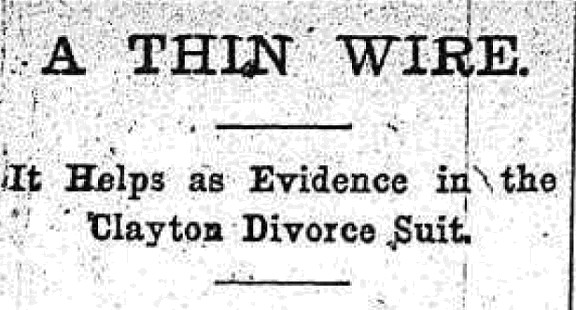THE CAT MAN OF GWINNET STREET (1896)

******************************************************************************************************************************** Brownstone Detectives investigates the history of our clients’ homes. The story you are about to read was composed from research conducted in the course of one of those investigations. Do you know the history of YOUR house? ******************************************************************************************************************************** Haasen-pfeffer is a German dish best served hot. A traditional German rabbit stew, it was brought over to the US by immigrants. (Hase is German for “hare,” and pfeffer is German for “black pepper.”) Although rabbits are the chief ingredient in the old-world dish, German immigrants in the early days of the country would often substitute squirrels. But never cats. Until Herman Fritsch appeared on the scene in Williamsburg in 1896. THE CAT MAN OF GWINNET STREET The locals were first alerted to the possible rabbit substitute in their stews when several neighbors heard a terrible racket occurring one night at Fritsch’s home, 168 Gwinnett Street (now Lorimer Street). As the neighbors listened, they began to hear a horrible howling coming from his rooms above a liquor store. They thought the cries sounded like “the screams of a child or woman in distress.” A consultation amongst several of the neighbors quickly took place, after which they decided that “murder was surely being committed in Fritsch’s apartments.” So Officer Lang of the Clymer Street Station was called for. While the neighbors waited, though, there was a last despairing shriek. And then all was still. OFFICER LANG ON THE JOB By the time Officer Lang arrived, “not a sound was heard” within the […]
GUERRILLA MARKETING IN A DRESS (1903)

******************************************************************************************************************************** Brownstone Detectives investigates the history of our clients’ homes. The story you are about to read was composed from research conducted in the course of one of those investigations. Do you know the history of YOUR house? ******************************************************************************************************************************** When Brooklyn saloon owners saw Carrie Nation entering their Broadway establishments carrying her ax, their first thought was to protect their liquor. But when that grand and radical old figure of the Victorian temperance movement approached their bars, they were stunned at her request. “Gimme a drink – or else!” The original goal of Nation’s ax-swinging was to promote the temperance movement through the visual image of the destruction of its foe – liquor. It brought new prominence to a movement whose most visual image to date had been old women lambasting the drinking ways of men. When she started swinging that ax, though, she got attention, and so, in extension, did the temperance movement. CARRIE NATION – COMES TO BROOKLYN? But Nation, whose anti-saloon message was promoted primarily in Kansas, was a shocking sight in the Eastern District of Broadway. She had recently visited New York City, though, and so no one was willing to challenge that ax in the bars up and down the avenue – even so close to the liquor center of Brooklyn – Bushwick Avenue. “Dressed in a plush sacque, a neat fitting skirt, an old fashioned bonnet and carrying in one hand a dilapidated carpet bag and in the other a wooden ax, a person, […]
SHE MASQUERADED IN MALE ATTIRE (1894)

******************************************************************************************************************************** Brownstone Detectives investigates the history of our clients’ homes. The story you are about to read was composed from research conducted in the course of one of those investigations. Do you know the history of YOUR house? ******************************************************************************************************************************** Poor Mrs. Emily Lund. She was not prone to wearing men’s clothing – at least not in public. But the night in 1894 that she did dress so, she was arrested and tossed in the slammer. Officer Michael Quinn of the Hamilton Avenue police station arrested Lund, on Van Brunt, in Red Hook (or “South Brooklyn”) near William. The 55-year-old domestic had been discovered there attired “in a pair of trousers, a vest and a long mackintosh.” THE NIGHT IN JAIL After spending the night in jail, she was arraigned in the Butler street police court the next day. Her husband, who could not bring himself to even show his face, had his mother appear in his place. She brought “an outfit of women’s clothing” for his wife. When “Emily could make no coherent reply to Justice Tighe’s questions as to why she masqueraded in male attire,” Mrs. Lund’s mother-in-law told the court that her daughter-in-law’s “mind was affected.” POSTSCRIPT: “WHAT HAPPENED TO EMILY?” OR “THE POWER OF PUBLIC SHAMING” Whether that was the truth or Emily’s mother-in-law simply found the explanation convenient and a good cover up of the actual truth, it is not known. What we can guess, though, is that the Lund family was probably the butt of […]
A CURE FOR WEALTH ON CLINTON AVE (1895)

******************************************************************************************************************************** Brownstone Detectives investigates the history of our clients’ homes. The story you are about to read was composed from research conducted in the course of one of those investigations. Do you know the history of YOUR house? ******************************************************************************************************************************** Along an avenue shaded with tall oaks and plane trees once sat the home of a rich old recluse who’d been swindled of nearly all of her life’s savings in her declining years. A “tumble down” and “badly dilapidated old three story frame house,” the structure “stood forlornly upon the lot at 439 Clinton Avenue in Fort Greene,” noted the Brooklyn Daily Eagle. The roof of the house was “surmounted by a queer little cupola, and the whole structure looks as if it might fall in at any moment.” In short, the Eagle sardonically noted, the house looked as if the owner, Mrs. Caroline Barry, had lived in it ever since the death of her husband “without either painting it or repairing it in any way.” The Eagle was likely going a bit over the top with regards to the house’s condition, as it seemed much out of place situated between stately structures of brick and brownstone all along Clinton Avenue. But as the house has been gone for more than 100 years now, it is impossible to know what its actual state was for certain. What we do know, though, is what it looked like from a drawing done by the newspaper and from Sanborn Fire Insurance maps. From the […]
THE NOTORIOUS DRUNKEN POLLY WALTON (1880)

In 1879, alcoholism was practically a crime. And in many cases it was to be punished all the more severely in order that a change might be affected in its indulger. You either drank or you stopped drinking. There was precious little middle ground and relatively little pity for the alcoholic. THE CASE OF POLLY WALTON Polly Walton must have faced some difficult circumstances in her life, as she had at one time had everything – a life, a career, a husband, and two lovely daughters who had married well and were happy in their lives. For Polly, though, something had gone seriously wrong. After her husband died and her girls were married, her life had become a series of mornings awoken on the floors of jail cells, recovering from far too much alcohol and far too little memory of what had transpired the night before. Frequently in front of judges, she had gotten very good at promising them everything they wanted to hear. Polly, though, was referred to in the court system as “an old offender.” She was expected to be seen again and again, slowly moving in a downward spiral until one day she was no longer around – a faceless victim of crime which brought her to her last confinement – the city morgue. “Polly has spent at least nine-tenths of the past five years in prison as a penalty for her passion for strong drink,” so stated the Brooklyn Daily Eagle. HER DAYS IN COURT On […]
A BED-STUY BUILDER “GOES ASTRAY” (1891)

******************************************************************************************************************************** Brownstone Detectives investigates the history of our clients’ homes. The story you are about to read was composed from research conducted in the course of one of those investigations. Do you know the history of YOUR house? ******************************************************************************************************************************** One of the more colorful builders in the Bedford-Stuyvesant area before the turn of the century was Ransom F. Clayton. Clayton and his wife Hannah purchased entire blocks for development and became rich reselling land and building brownstones for occupancy. Clayton, approximately 60 years of age in the early 1890s, was the founder of the building firm Ransom F. Clayton & Son. In addition to being a builder, he had also been a jack-of-all-trades – a Civil War veteran, an inventor, a nominee for City Controller with the Prohibition Party, and a director and the treasurer of the Ocean Palace Elevated Railroad. In 1891, though, he could add to that list the title of “scoundrel.” For, in that year, having some years previous turned over the reins of his building firm to his son, Clayton was now being given the opportunity to lose the property in a highly publicized divorce scandal. Several newspapers of the time hyperventilated over the steamy details of the case, from the “plain black gown” that Mrs. Clayton wore to court, to the description of “the other woman,” Mrs. Margaret F. Oakley, who was “tall,” “finely formed,” and “richly attired,” and further to, finally, how the crowd in the packed court room erupted in applause when the […]
Hijinks on Herkimer, Pt. II

(To see Pt. I of Hijinks on Herkimer) It was not too long before, on one specific occasion, Wolfram took notice of Clayton approaching and entering their apartment building. Wolfram must have had a mouse’s ear, because he discerned from the top floor of the building that Ransom had not come upstairs but had entered an apartment on one of the first two floors. Wanting further evidence against Mrs. Oakley, Wolfram slipped down the stairs and went around the side of the house and “walked slowly by” the windows attached to Mrs. Oakley’s apartment, one of which belonged to her bedroom. As the blinds to the flat were “just a little open,” Wolfram peered though and saw the married man, Ransom, in Mrs. Oakley’s bedroom, a scandalous show of moral laxity at the time. Two nights later, Wolfram viewed Ransom returning to the apartment building and, subsequently, to Mrs. Oakley’s apartment. Wolfram must have drawn murmurs from the gathered crowd in the courtroom when he said what he observed next: Ransom did not depart Mrs. Oakley’s apartment until 6 am the following day. Determined, on the third try, to get the evidence that he needed to have Oakley banished from his building, Wolfram decided he would convince himself once and for all that what he had seen was enough to have her removed. Going out into the house’s front yard, he took a piece of thin wire with him and “fastened it to the gate so that when it was […]